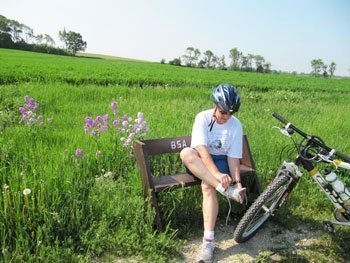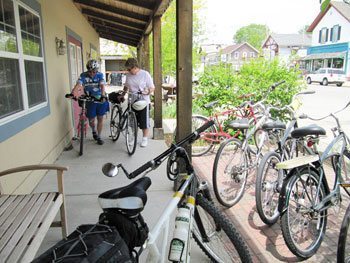Drumlin Trail: The Leisurely Way
By Mary Ann Noe

The early summer morning was heating up, so my friends and I stopped to stow our jackets on the back of our bikes. Just then, a deer looked up from the belly-high grass off the trail and fixed us with one of those whaddya-doing-here looks.
After a brief standoff, she swung around, raised her white surrender flag and took off, zigzagging across the field and into the woods.
We were on Wisconsin’s Glacial Drumlin State Trail, a path I’ve nicknamed, to borrow a phrase from Buddhism, the Middle Way. Interstate Highway 94 runs a few miles north of and parallel to the trail.
On the south, two-lane State Highway 18 saunters along, taking time for refreshment at several small towns along the way. Between the two is the most scenic — and the most leisurely — way to cover the same distance. The 52-mile rail-to-trail connects Waukesha to the east with Cottage Grove to the west.
The Drumlin is fine for all abilities, as it’s flat as a tabletop. Granted, it does slant a degree or two, to the advantage of those riding from west to east.
Starting Off
Cottage Grove, the western trailhead, lay just three miles east of Madison, the capital of Wisconsin. Before hitting the trail, we stopped at Madison’s Saturday morning Farmers Market, spread like a square dancer’s skirt around the capitol building. Two rounds of the market were a must, one to peruse, the second to purchase.

The fragrance of freshly baked pecan and apple pies sold by an Amish couple greeted us first and the temptation was great to hover. But froths of green overflowing stalls pulled us onward — lettuces of all kinds, asparagus, radishes, tomato plants, water cress.
Then came the breads and scones, cookies and coffee cakes, followed by honeys flavored with clover and apple blossom. Jams and jellies glowed in the morning sun, put up last season from strawberries, raspberries, blueberries, and rhubarb.
At last we reached my personal favorite, the cheese vendors. We sampled the traditionals, of course, but beyond that, the varieties were astounding. Horseradish, jalapeno pepper, garlic and tomato, aged cheddar, gouda, baby Swiss, and on down forty feet of table. Paired with buffalo jerky and something from Cedar Creek or Wollersheim wineries, and we were set for the trail.
A Worthwhile Diversion
Though we could’ve visited Frank Lloyd Wright’s Monona Terrace Community and Convention Center, we opted for pedestrians-only State Street, which ended at the University of Wisconsin campus. Our goal? The Daily Scoop.

For more than 90 years, this Student Union shop has sold ice cream made from UW’s Center for Dairy Research’s 400 cows. The milk is sent to the school’s Babcock Dairy Plant, where it’s churned into over 70 luscious flavors, like blue moon, peach praline, chocolate chip with molasses chips, orange custard chocolate chip, praline pecan and chocolate peanut butter. Yum! We chose the flavor of the day, settled down on the Union Terrace and watched sailboats tacking across Lake Mendota.
Time to Bike
The trailhead in Cottage Grove began in a well-marked parking lot. A coffee shop perched on the edge of the lot offered bakery items and plenty of liquid refreshments. Next door, Splurge, a cute gift shop, advertised “Nothing you need, everything you deserve.”
Unfortunately, we were a couple of hours too early to find out what we deserved. We saddled up and headed east through rolling hills and picturesque farmland, complete with cows.
Luckily, the railroad wanted to get from point A to point B as quickly as possible, without the extra strain of hills. So, while the land around us rippled like a blanket being shaken out, the trail remained sublimely flat.

Seven miles down the trail, we arrived in Deerfield. A five- or six-block side trip south on Main Street revealed a tiny downtown, with buildings dating back to the late 19th and early 20th century. The real treat was the old Victorian homes lining the road just beyond. The Painted Ladies were worth the detour.
The Pearl on the Chain
The trail into Lake Mills, nine miles from Deerfield, was a real treasure. Birdwatching was at its best as we crossed Zeloski Marsh, then headed into tunnels of greenery with openings offering vistas along Rock Lake. Swallows, goldfinches, a couple of orioles, and a gaggle of geese with goslings in tow crossed our path.
The Department of Natural Resources Trail Office was located in an old depot, right in town. Here we found not only restrooms, including a shower, but racks of helpful maps and brochures.
The rangers pointed us around the corner to a compact museum with specimens of local animals, birds and other little beasties, all those creatures we were seeing along the trail. We chose to venture further into town, but we could’ve chowed down at J&J Bar & Grill, right across the parking lot from the trail office.
The heart of Lake Mills was Commons Park, bordered by shops and restaurants, galleries and specialty shops. Every Wednesday morning, the park hosts a Farmers Market. A block away was Ephraim Faience Pottery.

Though it was closed the day we were in town, the vases and pots in the windows convinced us we need to make a return trip. Soft blue, green and mustard pottery pieces were embellished with lilies, orchids, herons, swallows. The arts and crafts items displayed were exquisite.
Lake Mills would be the perfect place to find a bed and breakfast and plant for a night. The town itself was charming, with plenty of shops and galleries to explore.
Not only that, a second bike trail looped around Rock Lake, easy riding past lovely lake homes, ranging from made-over cottages, to Victorians with wraparound porches, to a few Frank Lloyd Wright inspired designs. The views of lake, gardens, parks and beautifully tended neighborhoods made this an attractive side trip.
Chocolate and Beer
Lake Mills also boasted the Tyranena Brewing Company, only large enough to distribute their wares to four states. Just a step away from the large steel fermenting tanks was the German-style tasting room with its long bar and friendly servers, though we opted not to drink and ride that day.
Just down the road was James J. Chocolate. The day was hot, and the retail store was a welcome respite. Following that initial wave of cool, the aroma of chocolate and caramel spiraled right up our noses. Here was temptation we couldn’t pass up. Chocolate doesn’t impair steering ability, so we indulged with enthusiasm. Rum eggs, cherry cordials, pecan toffee, bridge mix, mint malted milk balls. I could’ve gone on and on, but my salivary glands were getting overworked.

Though these last two stops would require some effort to get to by bike, it is possible. However, we opted to drive. You can carry only so much beer and chocolate on a bike.
Who Were These People?
A couple miles east of Lake Mills, the Glacial Drumlin Trail intersected County Highway Q. A mile and a half north was Aztalan State Park, free for bikers. Aztalan is the state’s most important archaeological site, with 20 acres containing large, flat-topped pyramidal mounds and reconstructed stockades.
The mysterious inhabitants flourished more than 1000 years ago and were connected with the settlement at Cahokia, just east of St. Louis, Missouri. When Aztalan’s ruins were discovered in 1836, they were thought to be Aztec; hence, the name Aztalan. But plenty of questions remain today and research continues. Brochures were available for a self-guided tour of the stockades and mounds.
Exploring the Midpoint

The best way to explore the town of Jefferson was by car. How else could we enjoy the old-time flavor of the Hwy 18 Drive-In Theater, one of only ten left in Wisconsin? The County Fair is held every July at the Fair Grounds, right in town.
Jefferson hosts two major events in the fall. Gemuetlichkeit Days is always the second weekend after Labor Day. German music abounds, with choruses and tuba competitions, as well as polka dancing, of course. Euchre and schafskopf (sheepshead) tables are open for cardsharks. Hearty German food keeps everyone satisfied. A king and queen, already elected when we were there, reign over the festivities.
The Wisconsin Sheep and Wool Festival, also in September, brings shearers, shepherds, weavers, spinners, quilters and knitters together to celebrate their crafts. On an earlier visit, I watched Australian shepherds strut their stuff under the direction of handlers.
One particularly energetic black and white dog was sent out to retrieve three recalcitrant sheep out of sight over a knoll the length of two football fields away. The dog disappeared into the high grass. Until she went over the hillock after the sheep, only the tip of her tail rose now and then. With a few whistles, the handler sent out directions.

Within minutes, here came the sheep, bumbling along ahead of a frantic little dog, herding them along in a more-or-less straight line. She directed them into a small pen and lay down in front of the gate. She perked up her ears and looked to her handler, as if to say, “I did good, didn’t I! How about a treat?”
Stop for a Treat
My bike needed tending. The brakes were complaining, so we stopped in Dousman at the Bicycle Doctor Nordic Ski Shop, right on the trail. As with everything else, the moment I wheeled into the service door, the brakes went quiet. However, the mechanic on duty insisted on checking everything out anyway. Great service with a smile.
This called for a celebration, so we stopped in at The Coffee Vault Café for a wonderful herbed turkey wrap. Roasted sweet potato slices peeked out between turkey and Swiss cheese, topped off with a savory herb pesto.
“Real” bikers — the ones with clips on their cycling shoes and yellow jerseys — racked their road bikes and stopped in for lunch too. After sharing a couple of “war stories,” we scooted out and headed across the street for ice cream. This became a habit on the trail. Nothing carried the dust away like good ice cream.
Pavement!

The last 13 miles of the Glacial Drumlin Trail, from Dousman to Waukesha, are paved with asphalt, a real treat after miles of packed limestone. A bakery/coffee shop in Wales, about six miles from the eastern trailhead, would make a good stop, but we were anxious to dismount for good, so we pushed on.
Under a bridge, past an old beaver dam, across the Fox River and voila! The end of the trail. We were right in the city and close to downtown. From here, we could hook up with a number of other paths. But not just then. Other trails for other days.
Waukesha, the Final Stop
Waukesha, once known as the Saratoga of the West for its many mineral springs, celebrates its heritage with a well-stocked Historical Museum. Waukesha water was so valued that, in 1893, a local entrepreneur purchased a spring just outside the village limits and piped water to Chicago’s Columbian Exposition/World’s Fair.
Situated on both sides of the Fox River, Frame Park gave us a chance to stretch our legs on its three-quarter mile loop. Kids were making a happy racket on playground equipment and pickup games of baseball and volleyball were drawing crowds.

We followed the river walk another few blocks, with the intention of visiting some of the many art galleries, but got sidetracked a bit at Divino Gelato. Right across the street was Allo Chocolat!, which we saved for the return walk. We popped into a bookstore, a large antique mall, an old-fashioned malt shop, and several boutiques with windows full of intriguing clothing and jewelry.
Friday night was hopping, as people danced on sidewalks and in the street to four or five different bands scattered throughout the downtown area. Art Crawls are held four times a year as well, including in the winter. A dozen different restaurants, ranging from fancy to pub, were all within easy walking distance.
We came full circle when we went back to the riverfront Saturday morning. Waukesha’s Farmers Market, a smaller version of Madison’s, had that small town feel of neighbors rubbing elbows. Even the dogs greeted each other like old friends. The state apiary inspector was selling his crystallized honey.
“Don’t let anyone tell you to heat it,” he advised. “Just scoop it out and spread it. Bake with it too. Delicious!”
Along with the usual salad fixings of the season, potted plants were everywhere. And mushrooms, portabellas and morels among them, looked ready to sauté and eat right out of the pan.

A loaf of peasant bread, a bag of squeaky cheese curds, dried beef and smoked fish. Perfect ingredients for an al fresco lunch on the grass by the river. With bikes and bags stowed in the car, we had a perfect end to a fine adventure.
Trail Information
Developed in 1986, the Glacial Drumlin is one of Wisconsin’s premier bike trails and follows the old Chicago & Northwestern rail line. Any user over the age of 16 must purchase a day pass ($4). An annual pass ($20) allows access to all State Trails.
No wheels? No pass needed. Hikers, skiers, and snowshoers travel free.
In the winter, snowmobilers share the trail, but are not allowed on the easternmost paved section.
Accommodations are available in the towns, and camping is allowed in various spots along the trail itself.
Even in the winter, the trail seems to be active, with ice festivals and snowmobile rallies listed on some communities’ calendars.
Because of its variety and relative flatness, the Drumlin is a good trail for families or for those training for more serious endeavors. The paved eastern portion is perfect for beginning bikers. Visitors can tackle the entire trail, or choose to visit only a portion. For those less inclined to pedal or walk, many of the delights along the trail are easily reached by car.

So What’s a Drumlin?
Twenty-five thousand years ago, much of Wisconsin was under a great continental ice sheet. The landscape along the Glacial Drumlin Trail, particularly on the western end, was pushed and pulled by this ancient ice flow. As a result, the land was kneaded into hills, wetlands, ponds and rivers.
Various landforms owe their existence to the ice. The drumlins are long rounded ridges of land, lying parallel in groups of hundreds or more, whose length lies on the same axis as the movement of the ice. They somewhat resemble cigars lined up on a table.
If You Go
A very nice trail map, along with other information, is available at dnr.wi.gov
Check ephraimpottery.com for photos of Lake Mills Arts and Crafts pottery.
Go to dnr.wi.gov for details of Aztalan State Park.
Towns mentioned:
Waukesha

Mary Ann Noe, a retired high school English teacher, is practicing what she preached for 30 years by writing and publishing short stories and award-winning poetry, and extending her reach into novels and creative non-fiction.
- New Products for Fall That Will Surprise and Delight - November 29, 2024
- What Else Can You Buy Your Loved Ones? - November 27, 2024
- Manhattan Sights You’ve Missed All These Years - November 25, 2024







